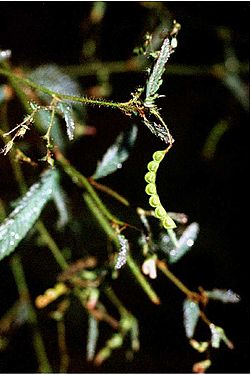| Aeschynomene americana | |
|---|---|
 | |
| Scientific classification | |
| Kingdom: | Plantae |
| Clade: | Tracheophytes |
| Clade: | Angiosperms |
| Clade: | Eudicots |
| Clade: | Rosids |
| Order: | Fabales |
| Family: | Fabaceae |
| Subfamily: | Faboideae |
| Genus: | Aeschynomene |
| Species: | A. americana |
| Binomial name | |
| Aeschynomene americana | |
Aeschynomene americana is a species of flowering plant in the family Fabaceae (legume) known by many common names, including shyleaf, [1] forage aeschynomene, [2] American joint vetch (United States and Australia), thornless mimosa (Sri Lanka), bastard sensitive plant (Jamaica), pega pega, pega ropa, antejuela, ronte, cujicillo, and dormilonga (Latin America). [3] It is native to Central America, parts of South America, the West Indies, and Florida. [3] It is now found in the US, in Australia and in South-East Asia. [4]
This plant is an annual or perennial herb growing up to 2 meters tall. The leaves are up to 7 centimeters long and have several pairs of linear to oblong leaflets. The sensitive leaves fold up when touched. The inflorescence is a raceme of flowers each up to a centimeter long. The flowers range in color from white to pinkish, orange, or purplish. The fruit is a curved legume pod up to 4 centimeters long made up of several jointed units, each unit containing a seed. [3]
This species is widely used as a green manure or pasture plant throughout the tropical world. [5] It is grazed by livestock and may be cut for hay. [6] Cattle readily eat the plant and spread the seeds on their coats and in manure. Available cultivars include 'Glenn'. [3]
In the wild it is generally a wetland plant, easily taking hold in wet places such as drainage ditches. [3] It is grazed by deer, and the seeds are eaten by wild birds. [4]
